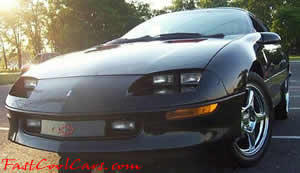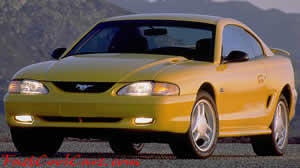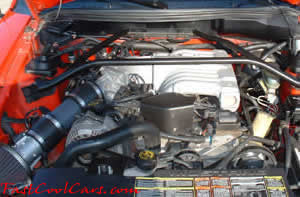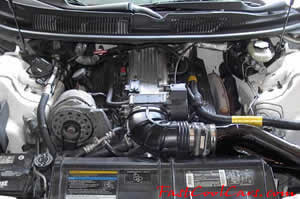
Home |
Horsepower Calculator |
G.M. | Ford
|
Chrysler |
Import |
Resources |
Wallpaper
Wheels |
Engines |
Interior |
Classifieds |
Cool Car Parts |
Forum |
Burnouts
| C5 Z06 Corvettes
Camaro Z28 vs. Mustang GT
 
Comparison 'Car and Driver'
test, December 1993
Pony Wars:
Camaro vs. Mustang
Check your excuses at the door: the Z28
and GT Square off. Again.
By Kevin Smith
Thirty years ago, in the spring of
1964, Ford invented the American two-plus sporty coupe when it popped the
Mustang on an eager public - A public that responded by ordering 22,000 cars
on the first day. Chevrolet was caught flat-footed and had to spot the
Mustang more than a million sales before responding with the Camaro in the fall
of 1966. Chevy's pony car quickly established itself as the Mustang's most
bitter rival, and the two have been brawling ever since - in showrooms, on
racetracks, and between the covers of magazines.
The Fortunes of war have varied over decades. But the report
from the front as 1994 gets underway shows the tide clearly running in
Chevrolet's favor. Against a commendably smooth and refined new Mustang, the
Camaro redesigned last year for it fourth generation, more than holds its own.
In fact, it kicks pony tail. In nearly every performance measurement we take,
the Camaro Z28 runs all over the Mustang GT.
As you'd predict for
otherwise similar cars, the 275-horsepower Camaro creams the 215-horsepower
Mustang in sheer speed. Our Z28 lunged to 60 mph in 5.4 seconds, while the GT
needed 6.1 By the 130
mph mark, the gap had ballooned with the Z28 reaching that speed in 26.6 seconds, versus 44.7 for the GT. The Camaro
ran the quarter-mile in 14.1
seconds at 101 mph, the Mustang in 14.9 seconds at 93 mph. Top speed? Same
story. Camaro: 156
mph. Mustang: 137 mph.
How about the contests
that don't reward brute power? The Camaro still held the upper hand. It
generated 0.86 g on the skidpad to the Mustang's 0.85, and stopped from 70 mph
in 167 feet, versus the GT's 179 feet. Around the short, 1.5-mile Waterford
Hills roadcourse, the Z28 consistently lapped a solid second faster, averaging
1:26.1 to 1:27.2 for the GT.
Test Results
|
|
acceleration, sec |
top speed
mph |
braking,
70-0 mph,
feet |
roadholding
300-ft skidpad, g |
0-30
mph |
0-60
mph |
0-100
mph |
0-130
mph |
1/4 mile |
street
start,
5-60 mph |
top gear
30-50
mph |
top
gear
50-70 mph |
CHEVROLET
CAMARO
Z28 |
2.2 |
5.4 |
16.8 |
26.6 |
14.1 @
101 mph |
5.5 |
12.0 |
12.1 |
156 |
167 |
0.86 |
FORD
MUSTANG
GT |
2.1 |
6.1 |
17.6 |
44.7 |
14.9 @
93 mph |
6.4 |
10.5 |
11.0 |
137 |
179 |
0.85 |
TEST
AVERAGE |
2.2 |
5.8 |
17.2 |
35.7 |
14.5 @
97 mph |
6.0 |
11.3 |
11.6 |
147 |
173 |
0.86 |
Vital Statistics
| |
price,
base/
as tested |
engine |
SAE net power/torque |
transmission/
gear ratios:1/
maximum test speed, mph/
axle ratio:1 |
curb
weight,
lb |
weight
distribution
% F/R |
CHEVROLET
CAMARO
Z28 |
$17,269/
$20,590 |
V-8, 350 cu in
(5733cc), iron block
and aluminum heads. GM engine-control system with port fuel injection |
275 bhp @ 5000 rpm/
325 lb-ft @ 2400 rpm |
6 speed/
2.66, 1.78, 1.30, 1.00, 0.74, 0.50/
47, 70, 95, 124, 156, 140/
3.42 |
3460 |
56.6/43.4 |
FORD
MUSTANG
GT |
$17,750
$19,150 |
V-8, 302 cu in (4942cc),
iron block and heads, Ford EEC-IV engine-control system with port fuel
injection |
215 bhp @ 4200 rpm/
285 lb-ft @ 3400 rpm |
5-speed/
3.35, 1.99, 1.33, 1.00, 0.68/
42, 71, 106, 137, 137/
3.08 |
3400 |
57.1/42.9 |
Of course, performance figures do not tell the whole story.
The new generation Mustang GT is a much sweeter automobile than this evidence
suggests. As we reported in a preview drive (October 1993), Ford's work to
improve the structural rigidity and suspension control of this chassis has paid
impressive dividends. The Mustang has a tight, polished feel that we would not
have thought possible from a platform whose roots are in the 1978 Fairmont.
Still, a shoot-out is a shoot-out, and the tradition of Camaro-Mustang faceoffs
gives little credit for finishing second at the track.
Ford Mustang GT
Highs:
Catchy new look, sophisticated new feel.
Lows:
Not enough beans, if there's a Z28 hanging around.
The Verdict: A fine, polished pony, but no one will notice
unless it gets more power.

|
|
Had the Z28's performance advantage come at a
huge cost in such areas as ride comfort, ergonomics, and noise control, we
might feel more reserved about its dominance. But in truth, the Camaro is
a refined piece as well. Ride quality is marginally stiffer than the
Mustang's but still entirely acceptable. And the extra racket is almost
all V-8 rumble - hardly objectionable in this kind of car.
The Camaro has a much racier feel, and impression that begins
when you plop into the driver's seat. It's a wide, low car, and the driver
looks out through a radically raked windshield and over a rapidly dropping
nose. By contrast, you sit bolt-upright in the narrower Mustang, the
higher hood running out to a blunt front end.
In both cars, the driver is surrounded by interiors and
instrument panels that are efficiently laid out, but the Mustang's clean
design is easier to look at. The Camaro's gauge cluster is garish by
comparison, but at least its instrument faces are now marked in white
rather than the jarring yellow of last year.
Seat comfort is better in the Mustang, even with some
pressure points at the lower back and under the thighs. The Camaro's seats
are flatter and feel less well made, offering little retention in hard
cornering, and they move around annoyingly due to frame flex and mounting
slack. Neither back seat offers more than minimal room, but most
passengers preferred the higher cushion location of the Mustang.
Light off the V-8 engines and they give vastly different
impressions. The Mustang's 302 almost suggests the quiet "adequacy" of a
Bentley Turbo R, while the Camaro's rowdy 350 sounds straight out of an
old Can-Am car. Both are flexible, strong, and smooth-running, with lively
throttle response and good fuel efficiency (both are projected to get 17
mpg on the EPA city cycle). When you want to get out of town, or just out
of a corner, neither V-8 cares much whether it's turning 2500 rpm or 4500.
Ford's venerable "5.0-liter" engine (which, as we've noted
before,
|
|
actually rounds to 4.9) is unchanged for 1994 except for
some repackaging of the inlet manifold to fit under the new hoodline. Chevy's
Corvette-derived LT1 goes to sequential fuel injection for 1994 and
employs a mass airflow sensor in place of the previous speed-density
system.
Under the whip, the Chevy 350 has bite to match its bark.
Between its 325 pound-feet of torque at just 2400 rpm and 275 horsepower at
5000, it delivers loads of sheer grunt anytime, anywhere. The Mustang's
numbers are tamer (285 pound-feet of torque at 3400 rpm, and 215 horses at
4200), and so is its personality. But reinforcements are waiting in the wings.
A 235-hp version of this engine appeared last year in the Mustang Cobra (and
ran third against a '93 Camaro Z28 and a Firebird Formula in our February 1993
issue). In spring of 1994, a 240- or 245-hp Mustang model will be available. |
Chevrolet Camaro Z28
Highs:
Performance to match its snarky shape and gutsy sound.
Lows:
Indifferent seats, exhaust rumble a bit much at times.
The Verdict:
Thrilling, fast, a good buy, and a clear winner.

Both Ford and Chevy back these V-8s with stout,
light-shifting manual gearboxes (or four-speed automatics). The Mustang's
five-speed may shift a little more cleanly than the Camaro's six-speed, but not
by much. And despite the different number of gearbox cogs and fractionally
shorter gearing overall in the Mustang, both drivelines span about the same
overall ratio range. New this year in the Camaro is the first-to-fourth
ship-shift feature intended to finesse the EPA's dyno program. It's a nuisance,
but it's also easy enough to defeat--a little extra speed or throttle before the
upshift will cancel it.
Four-wheel disc brakes are standard on both cars. The Camaro
comes with anti-lock brakes, the Mustang offers it as an option (out test car had
ABS). Alloy 17-inch wheels, 8.0 inches wide and fitted with 245-section Goodyear
Eagle ZR tires, are a GT option, and our car was so equipped. The Z28 rolled on
optional 245/50ZR-16 Goodyear GS-C tires on 8.0-inch-wide alloy wheels.
|
racecourse, min: sec |
interior sound level, dBA |
fuel economy, mpg |
|
idle |
full throttle |
70-mph cruising |
70-mph
coasting |
projected EPA city |
projected EPA highway |
C/D observed |
|
1:26:1 |
56 |
85 |
75 |
74 |
17 |
25 |
18 |
|
1:27:2 |
48 |
79 |
73 |
72 |
17 |
24 |
16 |
|
1:26:7 |
52 |
82 |
74 |
73 |
17 |
25 |
17 |
|
dimensions, in |
fuel tank gal |
interior volume, cu ft |
suspension |
brakes
F/R |
tires |
|
wheel-base |
length |
width |
height |
front |
rear |
trunk |
front |
rear |
|
101.1 |
193.2 |
74.1 |
51.3 |
15.5 |
53 |
29 |
13 |
ind, unequal-length control arms, coil springs, anti roll bar |
rigid axle, 2 trailing links, Panhard rod, torque arm, coil
springs, anti-roll bar |
vented disc/ vented disc;
anti-lock control |
Goodyear
Eagle GS-C, P245/50ZR-16 |
|
101.3 |
181.5 |
71.8 |
53.1 |
15.4 |
50 |
33 |
11 |
ind, strut located by a
control arm,
coil springs, anti roll bar |
rigid axle, 4 trailing links, 2 leading hydraulic links, coil
springs, anti-roll bar |
vented disc/ disc;
anti-lock control |
Goodyear
Eagle ZR45,
P245/45ZR-17 |
These aggressive, short-sidewall tires are managed fairly
effectively by both suspension systems. Neither car burdens its driver with
nasty ride characteristics or nervous direction changes. But the Camaro and the
Mustang cannot disguise their live rear axles, or their preference for
mirror-smooth road surfaces. Rotten pavement gets both chassis leaping and
crashing about. Still, under most conditions -- and for the money -- these cars
stick and steer well.
Splitting hairs, we'd say the Mustang is a little more calm
in the steering wheel and more compliant, and despite a little more body roll it
feels slightly better composed overall (though it was more nervous at top
speed). The Camaro feels sharper and reacts to the wheel more quickly. We
thought we could hear and feel what was going on down below a bit more plainly.
the Z28 also has a lower center of gravity.
Frankly, the Z28 has a lower everything. Call it
road-hugging height. The Camaro's rakish, droop-snoot lines look Concorde-quick
alongside the stubbier Mustang. Yet Ford performed a remarkable transformation
in reskinning this platform. The profile look great, the roofline is graceful,
and the tall glass gives better outward visibility than does the Camaro's
squashed greenhouse. Some eyes find the Mustang's details a bit overwrought,
with too many character lines and contour changes. But it's a ripping good
improvement on the previous rectilinear shape.
As performance values, the modern pony cars are tough to
beat. Prices in the $18,000-to-$20,000 range place these cars among such
front-drive coupes as Toyota's Celica, Honda's Prelude, and Ford's own Probe. In
that crowd, the speed and power of the V-8s look fabulous. There isn't a great
difference in cost: the base price of the Camaro is $17,269, and the Mustang is
$17,750. As we drove them, the Z28 cost $20,590 and the Mustang $19,150.
It's sad that the 1994 Mustang GT runs so far behind the
Camaro Z28, and it's obvious that Ford has undergone a change in philosophy with
its mythic pony car. All the same, Ford engineers and designers didn't put in
this painstaking job of refinement to have the result spoken of as a loser. They
deserve better. But so do the Mustang faithful. Sure, their beloved steed has
taken huge strides in styling and sophistication, but at Waterford Hills, it got
its haunches hammered by the archrival Camaro. Ring up the dyno room! Call in
the horsepower! And count on another battle in the War of the Ponies.
|
Mustang Versus Camaro
in Car and Driver
July 1968: The mother of all
Mustang-versus-Camaro shoot-outs. After C/D throws down the
gauntlet, Ford brings a "Tunnel Port" Mustang with unheard-of 60-series
tires and Chevrolet marches in a faster Z/28. Speed wins. Advantage:
Camaro.
August 1982: After the fuel-frenzied Seventies subside, C/D
revs up the muscle-car face-off once again. Mustang GT, Camaro Z28, and
Firebird Trans Am slug it out with Germany's finest, the Porsche 928. This
contest of "Red Speed" puts the Deutsche treat a mile away in
acceleration, top speed, and price. Among the domestics, the Camaro edges
the Mustang by a point. Advantage Camaro.
June 1983: A high-output 190-hp Z28 and a Mustang GT boosted to 175
ponies square off again for the GT championship. Testers find fault the
Mustang's drop-throttle oversteer and steering feel: "It feels like a
Mafia triggerman," notes Michael Jordan. The Camaro's extra speed and
better braking give it the nod. Advantage: Camaro
May 1984: C/D staffers search for the best-handling sports
car amont Chevy Corvette, Dodge Daytona Turbo Z, Mustang SVO, Camaro Z28,
and Pontiac Fiero 2M4. The Camaro runs away with honors. Advantage:
Camaro.
May 1985: A V-6 Camaro Berlinetta and a Mustang SVO compete for
best sports-coupe honors. The Camaro ranks eighth out of eight, while the
Mustang ties for fifth. The winner is the Audi Coupe GT, a blip on the
radar of sports-coupe history. Advantage: Mustang
July 1896: A two-door blood-red Mustang LX V-8 takes on a
limited-run Corvette-engined Camaro in "Dearborn versus Goliath." Winding
by beautiful Santa Barbara, sunny San Luis Obispo, and Jimmy Dean's splat
spot near Cholame, we vote the Mustang tops despite soggy brakes and a top
end 10 mph slower than the Chevy. Advantage: Mustang
June 1987: Looking for revenge, Chevy supplies us with a
standard-issue 5.0-liter Camaro. "These cars have fought off corporate
purges the way social diseases resist penicillin," says Chevy engineer Jim
Hall. A ten-pony advantage over the Camaro--and a curb weight one hundred
pounds lighter--lets the Mustang zip circles around the IROC-Z. A
half-second quicker in the autocross, the Mustang wins by a nose.
Advantage: Mustang.
February 1993: The brand-new Camaro and Firebird take on the
twelve-year-old Mustang, updated in 235-horsepower Cobra form. Though it's
relaxed and refined at cruising speeds, the Mustang gives up pure speed to
the GM pony cars. The Camaro edges out its stablemate by a hair, based on
lower price and sleeker styling. Advantage: Camaro.
---Martin Padgett Jr. |
|
On the Track
We took the Z28 and the
Mustang GT to Waterford Hills, a 1.5-mile road-course near Pontiac,
Michigan. Despite many tight turns and one steep hill, the track has a
straightaway long enough that both cars attained speeds between 100 and
105 mph at its conclusion. The circuit is also a cruel test of brakes.
In fact, what we noticed first was that the Camaro's brakes
required less pedal pressure than the Mustang's and were easier to
modulate. Having said that, the Z28's anti-lock system suddenly quit
anti-locking at the end of the straightaway, giving Kevin Smith a moment
in which to mentally review his last will and testament.
At ten-tenths, the Mustang's steering was more linear and
suffered less kickback than the Camaro's. The Z28's is more heavily
assisted--usually a plus at a tight track like this--but it tended to
evoke too much initial turn-in. So you spent the rest of the turn making
minute corrections to the Z28's wobbly line.
The Mustang's seat was also a winner, offering good thigh
support on max-lat turns. In the Camaro, on the other hand, you have to
scrunch up your left leg and wedge it as stiffly as possible against the
door panel, then brace your upper body by desperately clutching the
steering wheel. Or onto that huge medicine ball on the tip of the shifter.
Pushed to its limit, the Camaro didn't understeer as much as
the Mustang, in part because, with all the Z28's torque, a punch of the
throttle helped rotate its tail. That same torque carried the Camaro up
Waterford's steep hill with less effort than the puffing Mustang expended.
That section of the course alone may have given the Camaro a half-second
advantage.
The Camaro's suspension was always quicker to settle after
bumps and ham-fisted maneuvers. And the Z28's grip was marginally higher
when the chassis was unweighted, which is about always at hilly Waterford.
It feels like the Z28 has a center of gravity far lower than the
Mustang's.
Still, both cars were benign, predictable, and easy to drive
to their limits--particularly the Mustang, perhaps because it's slightly
slower, goes into understeer earlier, and felt as if its platform flexes
much less.
The winner? The Camaro, with an average lap of 1:26.1,
compared with the Mustang's 1:27.2. But given the Z28's 60-hp advantage,
we were surprised it prevailed by a measly 1.1 seconds. Which says a lot
for Ford's savvy chassis tuners, among them a wee Scot named J. Young
Stewart. He may sit on a pillow, but he seems to know what he's doing.
---John Phillips |
 |
|
engine |
trans-mission |
brakes |
handling |
ergo-nomics |
comfort |
ride |
utility |
value |
styling |
fun to drive |
OVERALL RATING* |
CHEVROLET
CAMARO Z28 |
9 |
8 |
9 |
9 |
8 |
6 |
6 |
6 |
9 |
9 |
9 |
85 |
FORD
MUSTANG GT |
7 |
8 |
7 |
8 |
8 |
7 |
7 |
7 |
7 |
6 |
7 |
74 |
HOW IT WORKS: Editors rate
vehicles from 1 to 10 (10 being best) in each category, then scores are
collected and averaged, resulting in the numbers shown above.
*The Overall Rating is not the total of those numbers. Rather, it is an
independent judgment (on a 1-to-100 scale) that includes other factors --
even personal preferences -- not easily categorized. |
There's the facts!
1988 Callaway Sledgehammer Corvette, One of the Worlds fastest Street Legal Cars, 254.7 MPH
FastCoolCars
|




